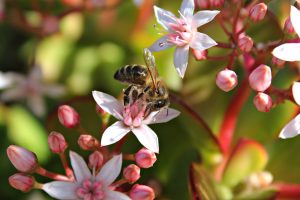
The keystone
About Keystone-ness
Learning Management Systems (LMS) and Virtual Learning Environment (VLE) are used to mean more or less the same thing. For example, the term LMS is used for Blackboard Learn in Australia and VLE for the same system in the UK. As I’m in Australia today, I’ve used the term LMS in this blog.
For me, LMSs are like keystone species of biological ecosystems. Keystone species play a crucial role in maintaining the balance of an ecosystem, which would collapse if that species was removed.

Some sea stars are keystone predators, maintaining the ecosystem by preying on species that don’t have other predators.
In 1997, only 7% of institutions surveyed in the UK used an LMS. By 2001, 81% of respondents ‘owned’ one or more LMSs, with 40% taking one up for the first time between 2000 and 2001 (UCISA, 2001). Implementation and integration was minimal, and staff and student engagement ‘very low’.
Now (2017) almost all colleges and universities worldwide use them and their scope has widened very considerably. They were oversold on the basis of ‘delivering’ learning, which sparked much debate about the predation of teaching staff—with their roles threatened by this new species that supposedly replaced the teacher as content-deliverer.
In 2017, there are around four dominant LMS providers globally (USICA, 2016). These have become highly complex enterprise-wide systems, often by acquiring a wide range of other technologies, or ensuring full and easy integration through modern integration tools offering more seamless experiences for students (read more about learning tools interoperability here). There’s more to go on this…
In practice, no LMS can ever ‘deliver’ learning and teaching but the LMS can and does shape, enable and limit learning design…a form of mutuality in the learning environment like a keystone! (More about learning design in a future blog post.)
So we move towards the 3rd decade of the 21st century with LMSs functioning as complex ecosystems. A full set digital learning tools are required as standard including enterprise-wide e-portfolios, rubrics, digital-first assessment and marking, a wide range of synchronous and asynchronous collaboration and interaction, blogs, journals, time-based communication, learning analytics to fully exploit the enormous amount of ‘big data’ that is collectable and usable from within the LMS—in short anything and everything that enables a move from one-way teaching towards learning together, integrates, adds value, and reduces costs.
In addition, LMSs are now are now the most significant enterprise-wide technology platform that impacts on students’ experiences in Higher Education. Effective use of the LMS is essential to enable the design, development and deployment of new models of learning, including functionality on mobile devices. LMSs contribute to avoiding expensive academic time delivering the same content repeatedly, increase the deployment and efficiency of physical teaching space on campus, and offer fully flexible, online digital learning to student cohorts (big and small) at all levels. The potential and value that LMSs could offer is now very large if they are aligned with university aspirations.
The main LMS providers are realizing that their futures may depend on focusing on the impact on the students’ learning experience and working in true partnership with institutions. Institutions should be looking to shape their critical mission of developing students’ experiences and enabling staff to embrace new ways of becoming learning leaders. With the optimum digital learning system, then academic staff, learning technologists and information specialists become the ‘engineers’ of the ecosystem rather than by-standers and recipients.

Beavers are ‘ecosystem engineers’—they create and modify their environment, affecting other species in the habitat.
I thought you might like to consider what I think are now the minimum requirements if LMS providers wish to continue their keystone-ness in promoting evolving learning in universities.
Here’s my list for today: Minimum requirements for a LMS in 2017. Yes the list is long, but we’re worth it!
Environment (technology)

- Fully digitally interoperable with University systems, especially the Student Records/Students Management System, and identity and access management systems as well as any other key external partners.
- Be cloud–based with unlimited free secure storage.
- Able to bring extensive and effective resources to DDoS attacks.
- Be mobile-first and fully mobile-friendly (mobile apps but also fully responsive to all current and futures devices of all sizes) – i.e. all channels and devices.
- Have the highest level of security and system responsiveness.
- Servers and repositories provided in local jurisdictions for avoidance of concerns about data protection and speed of access for students and staff.
Symbiosis (relationships)

- Reliable estimates of the time scales for the delivery of new features, apps, and new systems, so University projects can prepare guidelines and design pilots and prototypes to fully exploit the best and most appropriate of them.
- Be constantly kept up to date by the provider and external partner, with reductions in costs as appropriate, and good easy-to-use training and development resources for every change. The day has gone when any technology provider should expect the university to provide its own micro resources to enable staff to actually be able to use their product…or pay good university funds for consultants!
- Flexible enough to move with new opportunities in an agile way and provide frequent ongoing innovation and sustainability. Moving from one LMS to another is highly costly – traumatic for the university community even! Nowadays ‘content’ and ‘students’ can be successfully transitioned with effort. Academic staff much less easily.
- Increasingly offer embedded systems which are just as good or better than those of other providers (to avoid bits of the university purchasing elsewhere), and dramatically simplifying the number of partners the university works with, and pays.
Nutrients (learning processes)

- Good solutions to forward-looking learning and teaching models – e.g. easy constant feedback at the point of formative and summative submission, mobile learning and mobile fully embedded in the blend flipped classrooms and labs, digital-first assessment and marking, synchronous remote classrooms, as well as new models as yet undefined, i.e. driven by working with the academic community and pedagogical partnerships (not just ‘technical roadmaps’).
- Provide really powerful straightforward work flows for key functions e.g. digital-first submission of assessment and marking, offering fast feedback.
- Have an effective and supportive repository which is shareable and searchable across the institution, thus avoiding constant duplication and promoting cross disciplinary courses and support.
Energy flows (user experience)

- Student experience: Agile, flexible, easy to navigate, easy to use for the whole university community. Not much really!
- Staff and designers’ experience: Also agile, flexible, easy to navigate, easy to use.
- Staff development and learning design are the biggest factors in terms of time expenditure for the institution and of impact on students – well beyond platform and data migration costs. The LMS must be the enabler for staff development and learning design. This requires a Web based software environment (beyond the ‘menu select’): a contemporary ‘drag and drop’ is the minimum!
Just when you thought it was safe to come out of the cave, the future looms up very fast.

In the near future I would also expect:
- Effective Adaptive Learning tools and platforms so personalised pathways for students can be built in, supporting self-efficacy, independent learning and greater student success (retention and achievement).
- Tools for large classes.
- Easy and quickly developed ways of achieving future approaches to learning, e.g. flipped learning, flipped labs, mobile as blend.
- Much improved intuitive interfaces for students and staff, and ‘pop-up’ help in critical areas.
- A LMS that does not expect everything to be based on ‘courses’ and programmes’, credit hours and traditional methods of assessment and feedback., or ‘standard’ starts and finishes.
- Good decisions about whether a LMS really can/could provide social learning and communities of practice, or whether using existing social media within appropriate policies and supportive learning design is a better approach.
- Stronger awareness of accessibility to match the increasing number of students with accessibility needs – for example easy ways of students-led/choice alternatives for those with low vision, colour blindness, dyslexia, mobility issues, etc.
- New features and provision of appropriate partners for new and emerging technologies, e.g. AI, VR, 360 degree video, robotics.
So just one question to would-be LMS ecosystem learning engineers: what would you add, remove, adjust to this list? Let me know by leaving a comment below.
For a brief overview of futures for higher education as a complex evolving system, visit www.gillysalmon.com/learningfutures, see Education 1.0-3.0
Continuing to be a Keystone
Relationships and true innovative partnerships are what really matter. The power to achieve strategic objectives as an organisation lies not in the technology platform but in the commercial and trust relationships that can be built. The moment has arrived for universities to demand a ‘learning-first’ approach while enabling academic staff to be as comfortable in the LMS as they are in the lecture theatre.
Image credits
Arch voussoirs by Jhbdel. Creative Commons Attribution-Share Alike 3.0 Unported license
Cluster of ochre sea stars (Pisaster ochraceus) – keystone predator by D. Gordon E. Robertson Creative Commons Attribution-Share Alike 3.0 Unported license
Beaver photo from the U.S. Fish and Wildlife Service
References
Cook, R., & Obexer, R. (2014). A time for everything: reviewing an institution’s virtual learning environment. Presentation at ASCILITE 2014, Dunedin, New Zealand. Retrieved from http://www.ascilite.org/conferences/dunedin2014/files/fullpapers/84-Cook.pdf
Heathcote, L., & Palmer, E. (2016). Designing a review of the Learning Management System. Presentation at ASCILITE 2016, Adelaide, Australia. Retrieved from http://2016conference.ascilite.org/wp-content/uploads/ascilite2016_heathcote_concise.pdf
New Media Consortium. (2017). NMC Horizon Report > 2017 Higher Education Edition. Retrieved from https://www.nmc.org/publication/nmc-horizon-report-2017-higher-education-edition
Rouse, M. (2017). Distributed denial of service (DDoS) attack. TechTarget. Retrieved from http://searchsecurity.techtarget.com/definition/distributed-denial-of-service-attack
UCISA Academic Support Group. (2016). Technology enhanced learning survey. Retrieved from https://www.ucisa.ac.uk/publications/tel_survey2016
UCISA Academic Support Group. (2001). Management and implementation of Virtual Learning Environments: A UCISA funded survey. Retrieved from http://bit.ly/2o2BWNI
Virtual learning environments (VLE). (2016). Jisc. Retrieved from https://www.jisc.ac.uk/guides/technology-and-tools-for-online-learning/virtual-learning-environments
Wright, C., Lopes, V., Montgomerie, T., Reju, S., & Schmoller, S. (2014). Selecting a Learning Management System: Advice from an academic perspective. Educause Review. Retrieved from http://er.educause.edu/articles/2014/4/selecting-a-learning-management-system-advice-from-an-academic-perspective
All accessed 5.4.17
